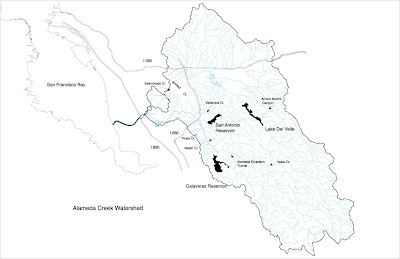
Doing a story for BioCycle Magazine on Urban Farms and their related urban ecosystem milieu. Went to meet with the owner, a friend of a friend, of The Ranch at Dogtown, a 14,000-square-foot urban farm that spreads over an acre and a half of property behind a high-ish sheetmetal gate at a ghetto-rattled corner in the micro-neighborhood Dogtown in West Oakland, a little piece of the rough-and-tumble city that bunches up against the freeway and the Oakland port and holds 25,000-ish residents. Where industry, metal working, recycling, etc., merge with rundown, dilapidated, forgotten neighborhoods. It's probably the most well-known, well-studied food desert in America. With UC Berkeley (see urbanfood.org) and the Bay Area, and affluence, humming all around, it's the perfect case-study in food insecurity, largely black, and my home.
Novella Carpenter started a semi-commercial farm in West Oakland and wrote a very good, well-acclaimed book about it, Farm City. She farmed a vacant lot in Ghost Town (a West Oakland mini-hood, like Dogtown), of which there are many, that bordered her rented place, and it stands about 10 blocks from me; and although the farm's story is told from an estranged position, Novella's very funny, self-effacing, and interesting in how she describes growing veggies, fruits, chickens, ducks, two huge pigs, among the Buddhist monks, families, street people, thugs and junkies that roam her street. Near the end of the book she writes what will be the underlying principle of my compost-focused urban farming article: "Although my holding was small - and temporary - I had come to realize that urban farming wasn't about one farm, just as a beehive isn't about an individual bee ... Urban farms have to be added together in order to make a farm." (Bold and italics mine).
Interesting flow of Novella's Ghost Town Farm still-active blog on getting her conditional-use permit. In Oakland, it's not permissible to grow food or livestock on a vacant commercially-zoned lot. If it was residential, no problem. And, just in April or June, Oakland allows Oakland residents to sell urban-farmed food with a fairly inexpensive, $40-ish, business license. Sets the stage for a possible new trend: hyper-local seasonal produce stands. See Novella breaking down her farm life, and the possible start of a roving, pipe-announced, dog-led goatherd providing fresh milk to her neighbors, here:
OBSESSIVES: Urban Farmer - on CHOW.com from CHOW.com on Vimeo.
-- Which begs the important question: Can any of this be done economically? Most of Oakland's urban farms are nonprofits and heavily underwritten by grants, subsidies, donations. While that's the case, the whole endeavor has a never-never-land feel. My sister-in-law works at an Oakland-based social equity thinktank, and she spends, as she says, some time on urban farming. She agrees that making it cost effective is the catch. While researching this urban food article, came across an organization that focuses on market urban farming and making a sub-acre farm profitable, SPIN, via a north East Bay industrial town's, Richmond, urban food org, Urban Tilth. A test case, from Pennsylvania's Department of Commerce feasibility analysis of Somerton Tank Farms: over the 4-year program, grossed, yearly, $120,000 per acre of urban farmland! And that's in Philadelphia! --Novella's farm has been down since March 2011, I think. Here's the flow from her blog: First finding out her farming is illegal, April 1, 2011; frustrated Novella asking for help with $, April 5, 2011; Novella almost losing it after finding another letter from Oakland enforcing some arcane policy/code, April 8, 2011; more peaceful, maybe it's working out, April 10, 2011; made $2,500 in donations for her CUP, April 12, 2001; no more summer gardening?, burn out?, May 28, 2011; no CUP yet, but a pop-up farmstand, October 25, 2011; aaaaannnnnnd that's it.
Tonight I went to the final class at Cal of a semester-long course in Edible Education, hosted by famed food author Michael Pollan and Nikki Henderson, executive director of a West Oakland food-equity organization, People's Grocery. It was funded by the famous Alice Waters of Chez Panisse and the Edible Schoolyard, an acre-big teaching garden, housed at MLK middle school in Berkeley. Each year 1,000 kids deal with its produce. Pollan was kind-of boring, as I've heard he is in person; Nikki was slightly overbearing and buzz-thoughty. She said the 25,000 West Oakland residents spend $58 million a year on food, which apparently is not a lot. Damn! That's for the poor in West Oakland. What an industry!
Spoke with former superintendent of education for the state of California, Delaine Eastin, today, too; she served for eight years around the turn of the century. She was awesome and nice. She started the A Garden in Every School program. She said, now, of the 9,000 public schools in California, 3,000, and possibly as many as 5,000, have food gardens used as teaching and eating laboratories. She shared one funny anecdote about visiting an elementary school in Union City, a working-class East Bay city a few miles south of Oakland, named after her; a child came up to her and asked, "Why did your parents name you after a school?" she said, laughing over the phone. She was cooooool.

Anyway ... the murals above were by a former art student, Mark Bode, of the Dogtown farmer Kathryn Porter, who commissioned Bode and some of his friends to colorfully mural (the geisha-girl) one of her ghetto-facing gates. She said to me, basically, "I guarantee that a brightly mural-ed wall will not be graffiti-ed." An acquaintance of hers down the street bought her logic and painted a mermaid-centered ocean-reef scene and a mammoth Moby Dick mural on his scrap-metal buying business. Moby's giant body destroys Ahab's boat and his giant spermy head engulfs docking trucks. Could be a future article: the murals of West Oakland.


























